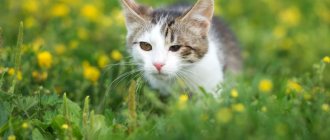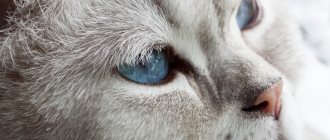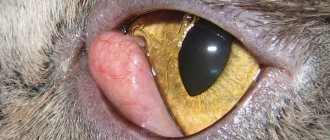The rarest cat breeds in the world are listed in the Red Book. This list includes the little-studied Caucasian forest cat, which lives in the countries of Central Asia, Eastern and Western Europe. She leads a secretive lifestyle and prefers hard-to-reach habitats.
What interesting things have experts learned about this rare breed, and what qualities attract the Caucasian forest cat? Is it possible to keep such a predator at home? You will find answers to these and other questions in our article today!
History of the species
The Caucasian forest cat is a small predator of the cat family, one of those wild animals that have retained their appearance unchanged over millions of years.
In total, there are 23 subspecies of forest cats, and the animal living in the Caucasus Mountains is one of its largest representatives.
The morphology of the animal was formed almost during the Ice Age. Most representatives of the fauna of the Pleistocene period of the Quaternary geological epoch did not survive to this day and became extinct due to global warming. These are, for example, mammoths, woolly rhinoceroses, cave lions.
Caucasian forest cats migrated to the cool zones of foothill forests and managed to retain abundant hair, sharp claws and impressive size for a cat.
Nutrition
The Caucasian forest cat is a predator. She freely climbs trees, but prefers to hunt on the ground. Its diet includes rodents of all kinds, lizards, fish, small birds, eggs and chicks. During a hunt, the animal can eat up to 20 mice. Hunting grounds per individual are up to 3 km2. In their habitats, they compete with raccoon dogs, badgers, striped raccoons, martens, and foxes.
The lack of the main object of hunting can force cats to hunt larger game. The diet includes pheasants, muskrat, nutria, hares and young ungulates. If possible, catch poultry. In addition, they eat small quantities of green cereals, fruits, insects and fresh carrion. Deep snow forces cats to migrate, it interferes with rapid movement and, accordingly, the extraction of food.
Mr. Cat recommends: characteristics, range of the Caucasian forest cat
The Caucasian forest cat is practically no different from its Central European counterpart.
The main characteristics of the animal's appearance are as follows:
- Quite large sizes. The weight of individuals is from 5 to 13 kg, while females are significantly smaller than males.
- Males reach 65-90 cm in length, cats 55-63 cm.
- The body is strong, massive, muscular. Females have a more graceful structure due to their less voluminous neck.
- The head is medium in size, but appears massive and round due to wide cheekbones.
- The eyes are quite large, yellow, green or swamp-golden in color.
- The ears are large, but not too large, set quite high, and have no tufts, only an inner edge.
- The legs are of medium length, but the hind legs are much longer than the front ones.
- The claws are sharp and strong; they are often ground down on rocks.
- The tail is long, matching the length of the body. It is powerfully pubescent, seems very thick, its tip is rounded.
- Medium length coat with voluminous undercoat.
- The cover is much thicker and longer in winter. In summer, the coat appears shorter and lighter.
- The color is in grayish tones with dark stripes and markings on the forehead, sides, and upper paws. There are several dark rings on the tail. Sometimes there are ocher and brownish colors.
- The vibrissae are large, voluminous and long, white.
- Coarse tufts of hair also grow between the toes on the pads of the feet.
Felis silvestris caucasica live mainly in deciduous mixed forests of the foothills of the Caucasus; they are found in Dagestan, Chechnya, Kabardino-Balkaria, North Ossetia, Georgia, Armenia, Azerbaijan, Adygea and Turkey. Their Central European and steppe counterparts often live next to these animals.
In the Krasnodar and Stavropol regions, this animal also inhabits foothill coniferous forests. In total, its habitat area in the Caucasus and Asia Minor is small, up to one and a half thousand hectares.
This is one of the smallest subspecies of the wild forest cat. So, in Dagestan there are only about a hundred individuals.
They are able to live at an altitude of 2-3 thousand meters above sea level.
In treeless areas, they inhabit floodplains - often flooded areas in river floodplains or near lakes, covered with reeds, thistles and shrubs. Although the beast does not like water.
Interesting Facts
Today, there are about 100 wild Caucasian forest cats. There are many legends about them, there are many historical facts.
- Difficult to train and completely unadapted to life in closed conditions, cats of Caucasian origin ended up with people and were even used as yard guards or for military purposes. These cats have a very worthy story!
- Many centuries ago, these cats were in great demand. The price for such a representative was equal to the cost of a large bull!
- Historical facts indicate the existence of the first Caucasian cats back in the time of the Duke of Wales. According to other data, domesticated cats of this species appeared 2700 years ago!
- Wild cats hiss more often, but if desired, they can produce quite decent meows.
- In just one hunt, more than 10 small rodents can be eaten. The total weight of food consumed per day often exceeds 0.5 kg.
- In winter, cats lose weight, and in summer they accumulate a lot of fat, which leads to a sharp increase in weight, approximately 2 times.
- For living they choose remote areas, primarily in the mountains at an altitude of 2500-3000 m above sea level.
- Due to the lack of small food, the Caucasian cat can hunt large game. Her catch may also include young large representatives of ungulates. It is difficult to imagine how this small predator manages to defeat such a large enemy, whose body weight and size significantly exceed the parameters of a small cat. But this fact has real confirmation!
Features of behavior
In forest foothills, the Caucasian forest cat usually makes a den in a tree in a hollow; it can also take a liking to the abandoned nest of a heron, an eagle or a stork.
In rocky areas, shelters become crevices in rocks, holes left by badgers, foxes, and sometimes even wolves.
In the floodplains, it can choose an entire island as its zone, arranging a den and a playground for the young in its center. The toilet area is usually located near the water itself.
Caucasian forest cats are very cautious animals that lead a rather secretive lifestyle, preferring a solitary existence.
One adult male usually chooses “his” territory of two to three square meters. km. Its boundaries are carefully marked with urine, and characteristic scratches are left on tree trunks.
They move to new lands extremely rarely and reluctantly, only due to human intervention or when the food supply is scarce.
It goes hunting in the twilight hours, before sunset or dawn. Never pursues prey, always uses wait-and-see tactics. It kills the victim in a swift jump, biting the back of the head or neck.
All forest predators that are comparable to or larger than the Caucasian cat are his enemies - bears, lynxes, wolves, foxes, martens, weasels, jackals. It is not easy to catch up with the animal; it immediately hides in a tree or in emergency shelters on “its” territory.
Security
The Caucasian forest cat is listed in Appendix II of CITES, Appendix II of the Berne Convention. It is protected in a number of nature reserves (Caucasian, Teberdinsky) and nature reserves of the North Caucasus.
It is necessary to expand the territories of protected areas. Biotechnical measures should be aimed at providing nest boxes in the deposits.
Felidae Kingdom: Animalia Phylum/Division: Chordata Class: Mammals Order/Order: Carnivores Family: Felidae Rarity Category: 3 – Rare IUCN Red List: No
Diet
The Caucasian forest cat is a medium-sized predator that is excellent at climbing trees and rocks. To hunt, the animal prefers to go down to the ground.
Most of its diet consists of rodents - mice, voles, dormice. I am ready to fight with such brave enemies as weasel, ermine, raccoon, rat, muskrat, nutria. Capable of catching a hare, snake, baby roe deer or deer.
Most of all he likes to hunt birds whose nests are located on the ground - pheasants, partridges, chukars, ducks.
Does not like to swim, but sometimes goes down to the water to catch fish, frogs or toads.
During the hungry season, it does not refuse lizards, insects, berries and herbs; it can enter human settlements and carry chickens, geese and turkeys, although it avoids people with all its might.
It does not move well in the snow, so it does not choose such areas for living and hunting.
The Caucasian cat eats a lot - an adult can eat up to twenty mice a day, and a teenager can eat about ten.
Details
Habits and daily habits of a wild cat
The species leads a secretive lifestyle, preferring to minimize its contacts with human territory. The best place of residence for the Caucasian forest cat is deciduous high-mountain forests, where it is possible to inhabit caves, cracks, and there are hollows in tall tree trunks.
Like many small wild cats, Caucasian cats and cats live on their own. A couple comes together only to conceive offspring. The rut begins in early spring, in February, by March all couples should finish courtship, and cats should begin to become pregnant.
After 65-70 days, the female gives birth to 2-6 kittens. Babies are born very similar to ordinary cats, but as they grow older, their instincts manifest themselves and reveal their wild essence. Until 4 months of age, the young live with their mother, who takes full care of them. Afterwards, joint hunting trips begin. By the age of 67, males leave their mother, begin to look for their own patch of forest and live independently. Female kittens remain with their mother for up to 9 months.
INTERESTING: At birth, kittens are much darker than their parents. With age, the fur coat turns pale and loses contrast.
The species matures quickly and after the onset of the year is ready to reproduce again. However, births are rare among young animals; most often, the female is ready to accept males after 3 years, and young males begin to be popular at about the same age.
When it comes to hunting, Caucasian cats are surprising in that the basis of their diet is mice, voles and dormouse. Ground prey attracts them most. Let us remember that the animal is quite large, from 6 to 10 kilograms, so during a hunting session it manages to catch and eat up to 20 units of small prey.
Another prey is rare for the species, but, nevertheless, the forest cat of the Caucasus can hunt for:
- Small birds that nest on the ground and in bushes;
- Lizards;
- Fish, frogs and toads, if the territory borders a river or stagnant lake;
- Rabbits or young hares;
- A large male can encroach on a pheasant, chukar, duck or nutria.
INTERESTING: the species is not capricious when it comes to food; even carrion, beetles and fallen fruits and berries are suitable.
If the cat is forced to share the boundaries of the territory with a person, then the issue of food will be solved at the expense of poultry. At the same time, catching a thief is very difficult. Natural caution allows the cat to harm the household for a long time and remain undetected.
The cat goes hunting, like any other species of small cat, at dusk. Loves ambushes and jump attacks. It is unusual for the species to track mice or other prey. Also, the forest cat does not like to hunt in trees, which are considered more as a refuge than a place of food.
But, despite all the severity and caution, there are many reasons for the disappearance of the Caucasian forest cat.
The first is human displacement from habitats, deforestation and depletion of the food supply. The second reason is that the natural enemies of cats also desperately fight for their territory and are not at all opposed to having a snack from a cat that has gaped in an ambush. The biggest problem is the lynx, it displaced the species from the Carpathians. Foxes and jackals also do not leave wild cats alone. But young animals often die because of martens, which an adult cat easily eats himself.
INTERESTING: now it’s becoming more and more difficult to call the species bloodthirsty. But research by zoologists proves that the more ancient representatives of the species were mostly large individuals and could get more than a meal for bustards, eagles, and roe deer.
Puberty and reproduction
During the year, this predator reproduces once or twice. A pair is created only during the rutting period and mating in February-March. Males often engage in fights for the female.
When pregnancy occurs, the cat prepares a den, lining it with moss, grass and bird feathers. After about two months, the offspring are born, containing from two to six cubs. Kittens are born with their eyes closed and are absolutely helpless. Their color is darker than that of adult animals, the spots are brighter and more distinct.
The babies feed on mother's milk until they are three to four months old, but the female begins to bring them prey from about one and a half months. At 60 days they are already learning hunting skills, actively playing in front of the hole and climbing trees. By six months, adolescents typically leave their mother.
Puberty in females occurs at 9-10 months, in males - at 2-3 years.
Life expectancy in captivity is 25-30 years, in the wild it is much less - 12-15.
Number
On the territory of the Dagestan Republic back in the 80s of the last century, there were only about 100 individuals of this species. Such a small number can be explained by intensive extermination in order to obtain valuable skins of these representatives of the cat family. Every year, more than 5,000 forest cats died as a result of hunting.
Nowadays, according to zoologists, the maximum possible number of individuals per 1000 hectares (10 km²) is 200-300 specimens, but on average this figure is much more modest - only 10-20.
Wild cats of the Krasnodar region occupy all its ecosystems. In the Caucasus and other habitat areas, their populations are small but stable. Ecologists keep accurate records of the number of individuals; it is extremely difficult to obtain such information, since this species prefers the most remote, difficult-to-pass forest lands.
Keeping the Caucasian forest cat in captivity
The Caucasian forest cat is undesirable in the house as a pet.
A kitten that is immediately weaned from its mother and hand-fed may show some signs of socialization before puberty. As it grows, a wild disposition will certainly develop, and the animal can become dangerous to humans.
It is better to allocate a separate large enclosure for an exotic pet so that the cat can actively move. You should not allow the animal to come into contact with other pets.
You should choose a complete meat diet, consisting mainly of poultry, rodents and vitamin and mineral supplements.
These cats, like domestic ones, need timely treatment for external and internal parasites and timely vaccinations.
The health of the Caucasian cat is excellent, but only if high-quality conditions of keeping and nutrition are provided.
Life at home
Caucasian forest cats raised in the wild are not the best option for keeping at home. The animal instinct and love of freedom predominate in them. Life indoors is a real test for both the animal itself and its owner.
The cat is unlikely to make friendly contact and will demand freedom with all its might. It can be aggressive, so the owner will have to exercise increased vigilance and caution when in contact with a feral animal.
If you want to have a Caucasian forest cat at home, look for such a representative in specialized nurseries where purebred kittens are bred, but more domesticated and adapted to living in enclosed spaces.
Kittens from the nursery have a more malleable character. Proper upbringing will allow you to raise a completely domestic animal with the exotic appearance of a real savage. The Caucasian forest cat is a real tiger in a smaller copy!
Caring for a wild Caucasian cat is standard. The diet is dominated exclusively by meat products, preferably fresh. This diet is common for cats from wild environments.
Purchasing a kitten
A kitten should only be purchased from a professional breeder. The cost starts from 35-40 thousand rubles. In foreign nurseries, prices are much higher.
You should think a hundred times whether such an unsociable, restrained in showing emotions, but at times aggressive pet is needed in the house.
In addition, as an endangered species, the Caucasian forest cat is listed in the Red Book of the Russian Federation. Its illegal acquisition and maintenance is punishable by law.
Description
The Caucasian forest cat is listed in the Red Book of Russia. As a rare species, it is assigned number 3. Protected in the Caucasian, Teberdinsky and other reserves. No special measures have been developed to protect animals. This is a subspecies of wild cat that lives in the Caucasus and Turkey.
Large, of the usual “yard” color - this is what the Caucasian forest cat looks like. Its description is presented below.
- Weight: males - 3.1-6.08 kg, females - 3.0-6.0 kg.
- Muscular body length: males - 50.1-67 cm, females - 52.3-61 cm.
- The length of the tail as a percentage of the length of the body is: in males - up to 60%, in females - up to 56%.
- The claws are large and sharp.
- The head is wide and rounded.
- The ears are round, up to 7 cm high.
- The mustache is long.
- The eyes are large, without eyelashes.
- The hairline is dense and luxuriant in winter.
Wild life has left its mark on the animal’s coat color:
- the general color is gray with a reddish streak, a black stripe runs along the ridge, there are dark stripes on the sides;
- black stripes are clearly visible on the head from the forehead to the back of the head;
- the bottom of the throat, belly, and groin areas are light, almost white, with an ocher tint, especially noticeable on the undertail;
- there may be vaguely outlined dark spots on the stomach;
- the tail is “decorated” with dark rings, the number is from 3 to 8.
This pattern allows animals to camouflage themselves for ambush hunting. It is brighter in summer and dims in winter. The cat prefers to hunt at night.
The mating season for cats begins in February-March. Pregnancy lasts 68-70 days. There are usually 3-5 kittens in a litter. They suckle their mother for up to 4 months. From the age of two months, the mother teaches them to get their own food. After six months, males leave their mother; girls can stay with her longer. Sexual maturity occurs at one year of age. The first offspring of young individuals appears by the age of three.
Cat food
Forest cats are small predators. Despite its small size, the animal has predatory instincts that are dangerous to others. Wild cats feed on small mammals: small rodents (mice, hamsters), rabbits, hares, muskrats. They also often hunt ferrets, weasels and stoats.
In addition, the animals feed on crayfish, fish, water rats and birds, mainly waterfowl. To immobilize the victim, wild cats jump onto its back from trees hanging over the pond. These animals are also merciless towards feathered birds from the order Gallini. In search of food, predators destroy their nests, eating eggs and chicks. To hunt squirrels, predators are able to climb the tallest trees.
Occasionally, in times of famine, representatives of this cat family hunt the cubs of larger animals. They also eat wounded roe deer, chamois and deer. These predators prefer to go hunting exclusively alone; even in times of food shortage, they will not share food with their brothers.
Reproduction
Cats gather together between the beginning of January and the end of March. Males in groups begin to hunt for the mother of their future offspring. In addition, the female is often pestered by simply stray cats who also want to mate with her.
Males fight among themselves from time to time. Fights occur both between males of the same species and with outbred cats. But in the end, not all the offspring turn out to be “pure”, since many females manage to mate with outbred males.
The father of the kittens is the male who shows his best side. That is, roughly speaking, the strongest and most resilient.
When a female becomes pregnant, she begins to look for the best place for the subsequent birth and maintenance of offspring. Cats very often settle in holes and hollows abandoned by their previous owners.
The female brings grass and feathers into the home, thereby making a kind of pillow for her children. She gives birth in 2 months, sometimes a little more time passes, but still the birth occurs in the spring - in April or May. Usually only 2-3 fluffy lumps are born, occasionally 4-5.
Newborn forest kittens are very weak and small, they weigh 200-300 grams. Therefore, the mother has to monitor them and feed them milk.
Forest kittens gain sight fairly quickly - in about 8-12 days.
At the age of a month, babies begin to slowly get comfortable and crawl around the house (at this time the cat should be especially attentive). At two months of age, kittens leave the house and go hunting with their mother. After this, the still small wild kittens begin to try to exist on their own, but their mother does not abandon them.
History of the origin of the breed
The era of the Quaternary period - the Pleistocene, which began more than 2.5 million years ago and ended approximately 11.5 thousand years ago, according to scientists, is the time of the emergence of the wild cat. Based on these figures, it is obvious that the wild cat is “older” than humanity, which arose about 2000 years ago; scientists do not know what it might have looked like at that time.
Typical wild forest cat
The end of the Ice Age, harsh climate, terrible weather conditions, followed by global warming, influenced the emergence and further development of the wild cat class.
Photo gallery: wild European forest cat
The European wild forest cat is tamed with great difficulty, and it is very difficult to keep it in captivity. The animal finds enclosed spaces extremely difficult. The genetically inherent wildness and independence cannot be overcome by training and education. However, many zoos around the world keep these animals, where they successfully breed.
Keeping a wild European cat at home is very difficult
From personal observations. Once upon a time, a wild kitten came into our house. He was picked up by a compassionate hunter he knew in the forest. The animal looked to be 5–6 months old. He hid under the closet, hissed and purred incessantly, and refused to eat. There was no question of picking it up. Sharp claws and teeth made the kitten dangerous to others.
It is hardly possible to keep a purebred cat in an apartment, because it is extremely uncomfortable for a predator to live there. Urban conditions are absolutely unsuitable for this animal. Kittens born in the wild inherit predatory instincts and a wary attitude towards people from their wild mother. A wild animal, adapted to natural conditions, requires some freedom and significant space to move. Therefore, a private household with the possibility of keeping a cat in a spacious enclosure is more suitable.
It is recommended to purchase small kittens (no older than 2–4 months) from professional breeders who have kept several generations of domesticated wild animals. In this case, the cat can be tamed. But she will still have an extremely freedom-loving, independent, and independent character and will never be affectionate.
It is recommended to purchase kittens from professional breeders
The diet of a wild European cat should be as close to natural as possible. His diet includes the following products:
- lean meat (beef, chicken, rabbit, etc.);
- dairy products;
- River fish;
- offal (liver, heart, lungs, etc.);
- eggs.
It is necessary to give your pet vitamin and mineral complexes. Animals are very fond of young cat grass and oat sprouts.
The diet of wild cats in captivity must be balanced
Proper care for these predators includes regular vaccinations, taking anthelmintic medications, trimming their claws, and cleaning their eyes and ears. It is necessary to take care of flea control agents (drops on the withers, collars, etc.). It is necessary to constantly comb the fur, especially during the molting period.
Genetically, the wild European cat has excellent health and strong immunity. However, with poor nutrition and poor living conditions, animals are susceptible to several diseases:
- Polycystic kidney disease. Multiple cystic formations in the renal pelvis, causing disruption of the urinary system.
- Glycogenosis. A very rare hereditary pathology caused by a lack of special enzymes. Kittens die in the first months of life.
- Hypertrophic cardiomyopathy. Pathology of the cardiovascular system, inherited.
- Retinal dysplasia. Causes decreased vision.
With good care, the lifespan of a forest cat in captivity reaches 30 years, which significantly exceeds the lifespan in natural conditions.
A wild cat has fluffy and thick fur. A wild cat hunts in winter. A European cat can wait for prey in ambush. In deep snow, it is difficult for a cat to walk far. During the daytime, a wild cat usually sleeps. A wild cat loves to hunt while sitting in ambush.
Many of us have only seen the wild European cat in the zoo; it invariably evokes affection with its gloomy and at the same time touching appearance. But this is a dangerous and serious predator, capable of standing up for itself in case of danger. The animal is not designed to live at home.
Amur forest cat interesting facts. Amur cat: In the taiga, even seals kill roe deer
Greetings, ladies and gentlemen. Creepy horror is, of course, good. But today we decided to please you with a cute creature. No, this is not the neighbor's cat Barsik, as you might think. Our guest was a proud representative of the forest cats. This animal will not only catch a mouse, but also punch you in the face when the opportunity arises. Say hello to the Amur forest cat! A beast with an extremely charming pug and an unbridled temper.
What are leopards and tigers like? This is who they should be afraid of in the Far East!
Let's start with the classics, with appearance. The forest pussy is larger than its domestic counterparts. The length of its body from the tip of the nose to the tip of the tail is 75-90 cm. The weight of the sheep is approximately equal to a bucket of cucumbers - 4-6 kg.
A thick and long fur coat protects the animal from wild frosts.
In China, our heroine is called “money cat” for the spots that decorate her fur. How the Asians saw the coins in the blurry patterns, I don’t know. But, in fairness, we note that the spots really bring material wealth to the animal. Camouflage helps to blend into the forest landscape, which significantly increases the hunter's chance of killing someone for dinner.
Darling, am I really your first?
This thing lives in the Far East, in the Amur River basin and along the coast of the Sea of Japan. Our hero has to share his shelter with larger and more popular brothers: the Far Eastern leopard and the Amur tiger. But don't underestimate this cutie. Local hunters talked about cases of the furry asshole attacking a person. He didn’t kill, but he fought and bit a lot!
It's a pleasure to die from such a cutie.
The cat eats a very standard diet: mice, voles, squirrels, birds. But as the famous advertisement says: “You are not you when you are hungry.” During the feast, the beast turns into a real killing machine. Unlike your four-legged lazy fellow, this wild hunter is capable of killing a whole roe deer! I don’t think it’s worth explaining the proportional difference between a cat and an artiodactyl, right? At the same time, the hunt ends successfully in 90% of cases. This is, his mother, a little berserker of the Amur taiga.
Valhalla is waiting for me
Furry messengers of death reach sexual maturity at the age of 1 year. The shepherds start screaming like crazy at the same time as your unsterilized Murka - in March. After a sneeze-puff, the female walks around with a little pot-bellied body for 65-70 days. On average, a cat gives birth to 2-4 kittens.
Amur cats are very good mothers. The female constantly moves her den to ensure safety for her offspring.
Unlike other cats, after satisfying his base needs, the male does not abandon the expectant mother, but remains with her. Moreover, he helps the female take care of their common babies: he brings food to the den and protects the kittens. The family idyll will not last long - only six months. At 6 months, babies go into adulthood to experience the delights and dangers of the Amur taiga on their own.
Amur cats live 15-18 years.
The cute fluffy animal is listed in the Red Book. Man not only cut down the forests where our spotted friend lives, but also purposefully shot the cat. And all because a skilled hunter easily plundered the farm. Rabbits, chickens, ducks, geese and even piglets fell victims to this forest dweller. In general, you can’t expect anything else from the Amur Berserker.
The embodiment of the harsh spirit of the taiga.
The Book of Animals was with you.
Thumbs up, subscription - support for the author’s work.
Habitat and role in the ecosystem
The forest wild cat can be found in certain parts of Europe, in Asia Minor, in the southwestern regions of Ukraine, as well as in Russian territories up to the Caucasus Mountains. The animal prefers to settle in remote, remote mixed deciduous broad-leaved forests (sometimes coniferous). It can live in mountainous areas (rocky areas) at an altitude of more than 2–3 km. Sometimes it chooses river banks for habitat, settling in dense bushes or reed thickets.
Wild cats establish permanent dens in abandoned badger and fox holes or in the hollows of large trees, without climbing too high. The dwellings are lined with dry litter consisting of leaves, grass, small branches and feathers. Temporary shelters are depressions under steep rocky slopes, small holes, or simply a dense interweaving of branches. The animal often uses old abandoned nests of large birds (herons) to rest.
Wild European cat may make temporary shelter in trees
In the warm season, it often changes rookeries, trying to escape from fleas and other blood-sucking parasites, which especially plague the animal in summer. In the midst of winter, it can use one den for a long time, since it is difficult to move through deep snow. There have been cases when forest cats settled in the attics of granaries, cottages, sheds and other buildings.
An animal that settles near human habitation can cause significant harm, as it will prey on poultry. Since in some cases a cat eats only small rodents, it is often beneficial in the wild. But it can destroy eggs and chicks of valuable bird species (turk, pheasants, etc.).
Habitats
Wild cats of the Caucasus are also represented by steppe and Central European subspecies. The territories they inhabit stretch from the Black Sea coast to mountainous regions of 2500-3000 m.
The best biotopes for life are virgin broad-leaved forests, but the Caucasian forest cat is also found in the coniferous forests of the Krasnodar Territory and adjacent areas.
Global habitat - the entire Caucasus and Asia Minor. The total area of temporary and permanent places where they can be found is about 1,360 thousand hectares. The nature of these places is diverse: crooked forests, beech groves, fir forests, rocky slopes, sparse trees.











